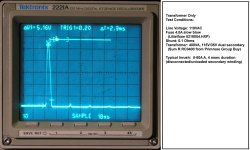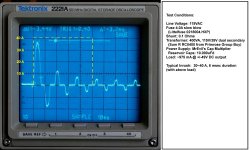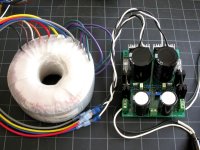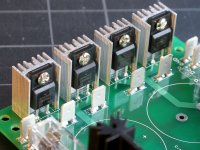Hi,
Well, I opened my [RC0600 915 5] and they are not potted (as ordered). They do fit in the EUVL F5X chassis, with a few mm of give actually. I can see from the pics that those potted ones will not fit, unfortunately.
I didn't specify potted in the order either. I hope Justin can convince Richard to wind me another unpotted pair for the group price. Usually it is nice to get extras for something that I didn't pay for, but not this time
I got mine earlier this week. The box was beat up but the transformer appears to be OK. But I was a little surprised that I had to pay an addition $25.20 for postage due. This caused a delay in actually getting the transformer because I had to take time off to make it to the post office to pay the shipping.
No they didn't give a reason other than implying that not enough postage was paid by the sender. I will have a look at the box since it had the postage info written on it but I have to get home from work first.
If my memory is correct original postage paid was around $10 or $11 plus change and they wanted a total of $36 plus change which seems kind of steep. I just checked on the USPS web site and a regular post from the east cost to here is $26.87 for an 11 pound package and the package has to be over 25 pounds to get above $35. Not sure how much this package weighed but the transformer itself is slightly over 8 pounds and the packaging couldn't be more than 3 or 4 pounds.
If my memory is correct original postage paid was around $10 or $11 plus change and they wanted a total of $36 plus change which seems kind of steep. I just checked on the USPS web site and a regular post from the east cost to here is $26.87 for an 11 pound package and the package has to be over 25 pounds to get above $35. Not sure how much this package weighed but the transformer itself is slightly over 8 pounds and the packaging couldn't be more than 3 or 4 pounds.
I'd question the post office. I've had a couple run-ins at the local office. One guy who works at the counter and sorts mail always adds postage on greeting cards and and envelopes with more than two sheets of paper and when I ship he weighs and measures everything ten times and checks his book to get the highest rate. And they're the laziest bunch of people I've ever seen.
I had to ship a PCB to England and they quoted me over $10 to ship a small padded envelope. I went to the next town and they charged me $3 and change.
I had to ship a PCB to England and they quoted me over $10 to ship a small padded envelope. I went to the next town and they charged me $3 and change.
That would happen if the Post Office used a different rate, by mistake or intentionally.I got mine earlier this week. The box was beat up but the transformer appears to be OK. But I was a little surprised that I had to pay an addition $25.20 for postage due. This caused a delay in actually getting the transformer because I had to take time off to make it to the post office to pay the shipping.
My empty transformer box and packaging weighed about 8 ounces ( I just re-purposed it the other day...
It has been happening lately. My local post office stopped accepting padded envelopes with anything hard inside, like a circuit board, or a short plastic tube of parts, mailed as a package, even if it meets the published rules for padded envelopes in every other respect. Basically they bump the postage into the package category, which can mean $9~10 postage to Europe instead of $3-4.
I am wondering if anyone has started using their transformer, or done any testing.
I have noticed some mechanical hum or buzz (no pun intended!) at rectifier frequency (2x mains f) when loaded with the typical bridge-rectifier/cap filter. Not enough to annoy me, but more than some people would like for a completely quiet power supply.
Aside from that, I started doing some tests for inrush, and load regulation with a couple versions of Mr Evil's Cap Multiplier PSU.
(Same psu pcb that I know a couple people here have ordered).
For those cases specifically, see results below:
The first picture shows worst case inrush captured w. transformer alone and no load. Second pic shows a more realistic inrush with a 10.000 uFd filter cap. Large filters will produce greater inrush. The inrush measurement is normalized to 10 amps per division on the screen. The yellow dotted line is part of a separate discussion (OT here). Third pic shows transformer and PSU used in the test.
I have noticed some mechanical hum or buzz (no pun intended!) at rectifier frequency (2x mains f) when loaded with the typical bridge-rectifier/cap filter. Not enough to annoy me, but more than some people would like for a completely quiet power supply.
Aside from that, I started doing some tests for inrush, and load regulation with a couple versions of Mr Evil's Cap Multiplier PSU.
(Same psu pcb that I know a couple people here have ordered).
For those cases specifically, see results below:
The first picture shows worst case inrush captured w. transformer alone and no load. Second pic shows a more realistic inrush with a 10.000 uFd filter cap. Large filters will produce greater inrush. The inrush measurement is normalized to 10 amps per division on the screen. The yellow dotted line is part of a separate discussion (OT here). Third pic shows transformer and PSU used in the test.
Attachments
Last edited:
One bridge, 4 discrete diodes.Are you using a dual bridge rectifier?
Attachments
I was reading about it a lot. There is a big chance that this is due to DC in AC line. Toroids are very sensitive to it especially SumRs where everything so tight and made up to specs.
There is a good DC filter that maybe can solve the problem (shouldn't harm for sure):
There is a good DC filter that maybe can solve the problem (shouldn't harm for sure):
An externally hosted image should be here but it was not working when we last tested it.
- Status
- This old topic is closed. If you want to reopen this topic, contact a moderator using the "Report Post" button.
- Home
- Group Buys
- Primrose(SumR Audio) Toroid GB



